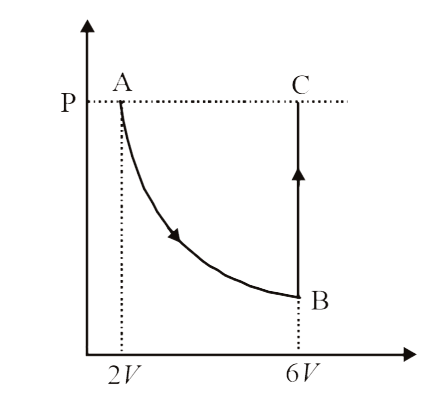Heat given to system containing monoatomic gas is Q . Q/4 work done by the gas then molar heat capacity is
R2
R
3R2
5R2
To solve the problem, we will use the first law of thermodynamics and the properties of a monoatomic gas. Here’s the step-by-step solution:
Step 1: Understand the Given Information
We are given:
- Heat added to the system, Q
- Work done by the gas, W=Q4
Step 2: Apply the First Law of Thermodynamics
The first law of thermodynamics states:
Q=ΔU+W
Where:
- Q is the heat added to the system
- ΔU is the change in internal energy
- W is the work done by the system
Step 3: Substitute the Values
Substituting the known values into the equation:
Q=ΔU+Q4
Rearranging gives:
ΔU=Q−Q4
ΔU=4Q4−Q4=3Q4
Step 4: Relate Change in Internal Energy to Molar Heat Capacity
For a monoatomic ideal gas, the change in internal energy can also be expressed as:
ΔU=nCvΔT
Where:
- n is the number of moles
- Cv is the molar heat capacity at constant volume
- ΔT is the change in temperature
Step 5: Equate the Two Expressions for Change in Internal Energy
Setting the two expressions for ΔU equal gives:
nCvΔT=3Q4
Step 6: Express Heat Transfer in Terms of Molar Heat Capacity
The heat added can also be expressed as:
Q=nCΔT
Where C is the molar heat capacity we want to find.
Step 7: Substitute Q into the Energy Equation
From the equation Q=nCΔT, we can express ΔT as:
ΔT=QnC
Substituting this into the internal energy equation:
nCv(QnC)=3Q4
This simplifies to:
CvQC=3Q4
Step 8: Cancel Q and Solve for C
Assuming Q≠0, we can cancel Q:
Cv1C=34
Thus, we have:
C=43Cv
Step 9: Determine Cv for a Monoatomic Gas
For a monoatomic gas, the molar heat capacity at constant volume is:
Cv=32R
Where R is the universal gas constant.
Step 10: Substitute Cv into the Equation for C
Substituting Cv into the equation for C:
C=43(32R)=2R
Final Answer
The molar heat capacity C is:
C=2R
We are given:
- Heat added to the system, Q
- Work done by the gas, W=Q4
The first law of thermodynamics states:
Q=ΔU+W
Where:
- Q is the heat added to the system
- ΔU is the change in internal energy
- W is the work done by the system
Substituting the known values into the equation:
Q=ΔU+Q4
Rearranging gives:
ΔU=Q−Q4
ΔU=4Q4−Q4=3Q4
For a monoatomic ideal gas, the change in internal energy can also be expressed as:
ΔU=nCvΔT
Where:
- n is the number of moles
- Cv is the molar heat capacity at constant volume
- ΔT is the change in temperature
Setting the two expressions for ΔU equal gives:
nCvΔT=3Q4
The heat added can also be expressed as:
Q=nCΔT
Where C is the molar heat capacity we want to find.
From the equation Q=nCΔT, we can express ΔT as:
ΔT=QnC
Substituting this into the internal energy equation:
nCv(QnC)=3Q4
This simplifies to:
CvQC=3Q4
Assuming Q≠0, we can cancel Q:
Cv1C=34
Thus, we have:
C=43Cv
For a monoatomic gas, the molar heat capacity at constant volume is:
Cv=32R
Where R is the universal gas constant.
Substituting Cv into the equation for C:
C=43(32R)=2R
The molar heat capacity C is:
C=2R
Topper's Solved these Questions
Similar Questions
The molar heat capacity for an ideal gas
View Solution
In the figure n mole of a monoatomic ideal gas undergo the process ABC as shown in the P-V diagram. The process AB is isothermal and BC is isochoric. The temperature of the gas at A is T0 total heat given to the gas during the process ABC is measured to be
Q. The average molar heat capacity of the gas in process ABC is
View Solution
Knowledge Check
Molar heat capacity of a gas is
AExtensive propertyBIntensive propertyCChemical property of gasDColligative propertyHelium gas is subjected to a polytropic process in which the heat supplied to the gas is four times the work done by it. The molar heat capacity of the gas for the process is: (R is universal gas constant)
AR/2BRC2/RD3/RThe ratio of P to V at any instant is constant and is equal to 1. for a monoatomic ideal gas undergoing a process. What is the molar heat capacity of the gas?
A3R2B4R2C5R2D0
600J of heat is added to a monatomic gas in a process in which the gas performs a work of 150J. The molar heat capacity for the process is KR. Then find K.
View SolutionMethod 1 of Q
Temperature of two moles of a monoatomic gas is increased by 300 K in the process p∝V.
(a) Find molar heat capacity of the gas in the given process.
(b) Find heat given to the gas in that.
View Solution1 mole of rigid diatomic gas performs a work of Q/5 when heat Q is supplied to it. The molar heat capacity of the gas during this transformation is xR8, The value of x is ........... [K = universal gas constant]
View SolutionThe ratio of P to V at any instant is constant and is equal to 1, for a monoatomic ideal gas under going a process. What is the molar heat capacity of the gas
View Solution600J of heat is added to a monoatomic gas in a process in which the gas performs a work of 150J. The molar heat capacity for the process is
View Solution
